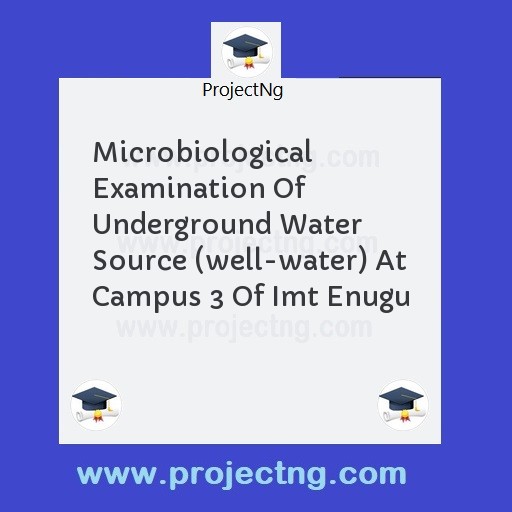Microbiological Examination Of Underground Water Source (well-water) At Campus 3 Of Imt Enugu
Science Lab Technology Project Topics
Get the Complete Project Materials Now! »
MICROBIOLOGICAL EXAMINATION OF UNDERGROUND WATER SOURCE (WELL-WATER) AT CAMPUS 3 OF IMT ENUGU
ABSTRACT
The examination of underground source (well water) at campus 3 of IMT Enugu was carried out, by using ten samples of the water sample. For viable plate count for presence of pathogenic organisms and organisms indicating organic matter pollution, plating technique of poor plates were used. Also presence of coliform groups and escheriachria coli were examined using presumptive coliform, test confirmatory and completed test techniques. The media used included nutrient agar, macconkey agar, and brilliant green bile agar, maccnokey broth and brilliant green bile broth. The total viable plate count gave 5 CFU per each for pathogenic organisms indicating organic matter pollution whereas the presumptive test showed the presence of coliform groups in eight samples out of ten samples and presence of escherichria coli in seven samples out of ten. The comfirmatory tests showed the presence of coliforms groups in six samples out of ten and presence of E. coli in four samples out of ten.
Whereas, the completed test gave the highest coliform count of 2 CFU in one sample and 1 CFU each in three samples, while only one sample out of ten gave 1 CFU for E. coli count. And the mean count for coliform, for the completed test was 0.6 CFU. The results indicated the presence of coliforms and E. coli, but the microbial load was minimal in all the tests. Therefore, the underground water source (well water) at campus 3 of IMT, Enugu is not fit for drinking though can be used for washing clothes and bathing.
TABLE OF CONTENT
Title Page
Certification
Dedication
Acknowledgement
Abstract
Contents
CHAPTER ONE
1.0 Introduction
1.1 Aim and objectives of the study
1.2 Hypothesis
1.3 Significance of the study
1.4 Statement of the problem
1.5 Limitation
CHAPTER TWO
2.0 Literature review
2.1 History of water purification
2.2 Sources of water
2.3 Underground water contamination
2.4 Biodegradation
2.5 Underground water/water protection
CHAPTER THREE
3.0 Materials and Method
3.1 Materials (see appendix)
3.2 Methods
3.2.1 Sterilization
3.2.2 Collection of well water samples
3.2.3 Preparation of culture media
3.2.4 Plating techniques for water analysis
3.2.5 Microbial count, gram staining and microscopic examination
CHAPTER FOUR
RESULT
4.0 Total viable count
4.1 Presumptive test
4.2 Confirmatory test
4.3 Completed test
CHAPTER FIVE
5.0 Discussion
CHAPTER SIX
6.0 Conclusion
6.1 Recommendations
Appendix
REFERENCE
CHAPTER ONE
1.0 INTRODUCTION
The amount of ground water varies considerably from place to place and is obviously greater where the surface rock is porous such as limestone and chalk than it is in areas of non-porous or impermeable rock such as clay. Ground water is responsible for the formation of spring and under ground.
Under ground water (well water) is stored water below ground, formed by rainfall. It can be obtained by digging a hole through the earth surface until the water table is reached. It must be sunk to the depth of the permanent water table, if a constant supply of water is to be obtained (Allen 1975).
The water table falls during dry seasons but will not fall to dryness. And if it is deep enough it remains on the saturated zone. There are two types of well water, they are: the shallow/surface well water and deep well water. Water from deep wells tends to be less polluted than that from surface/shallow well (world health statistics 1972).
Ground water is used for several purposes such as washing, cooking, food processing and among others. Out of these used drinking of water seems to be the sensitive as it could have a direct deleterious impact on health of human beings. Therefore, drinking water should be potable, so free from toxic substance (Letrotal 1980).
According to Thekoronye and Ngoddy (1985) water is potable when it is colourless, odourless, tasteless and free from bacteria. A few substances and microbes that are health hazards do occur in water, and can cause illness. From microbiological point of view, the pathogens most frequently transmitted through water are these, which cause infection of the intestinal tract, like dysentery, cholera, and typhoid fever.
The world health organization (WHO 1982) have standard for potable water of which coliforms should be absent and total plate consist of bacterial growth should be 100 CFU/ml of water.
There are two types of water, namely:
i. Soft water
ii. Hard water
Soft water is a example of pipe water because the water is treated with some organic substances. Whereas hard water is an example of ground water because it contains calcium and magnesium, hard water will not form lather
Be the First to Share On Social

Enjoying our content?
Don't miss out on new videos! Subscribe to our YouTube channel for more awesome content.
Subscribe Now!













